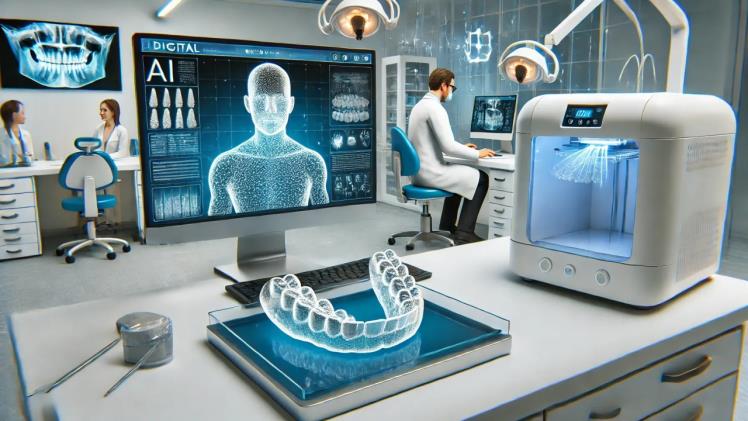The field of orthodontics has always focused on creating better smiles through precise diagnosis and treatment. With advancements in technology, Artificial Intelligence (AI) is now becoming an integral part of orthodontic care, significantly improving how treatment is planned and executed. AI helps orthodontists make more informed decisions by analyzing complex data, predicting tooth movement, and optimizing treatment timelines. In this article, we explore how AI is being used for orthodontic treatment planning, the prediction of tooth movement, and the overall benefits of integrating AI technology into orthodontics.
How AI is Transforming Orthodontic Treatment Planning
AI’s ability to process vast amounts of data and identify patterns is revolutionizing orthodontic treatment planning. Traditionally, orthodontists rely on manual analysis of dental impressions, X-rays, and photographs to determine the best course of action for aligning teeth. This process requires considerable time and expertise. With AI, orthodontists can now access a more streamlined approach to treatment planning that is efficient, accurate, and patient-centric.
AI-powered orthodontic software can analyze digital impressions, X-rays, and CBCT scans to generate highly detailed 3D models of a patient’s teeth and jaw structure. These models allow orthodontists to visualize different treatment options, evaluate the relationship between teeth and bones, and plan effective treatment strategies. AI also helps in automatically identifying anatomical landmarks, determining misalignments, and suggesting corrective actions, reducing the manual work required for orthodontic analysis.
Solutions like Diagnocat are leading the way in integrating AI into dental and orthodontic imaging. By providing automated analysis of dental scans, Diagnocat helps orthodontists make data-driven decisions, ensuring that each treatment plan is optimized for the best possible outcome.
Predicting Tooth Movement with AI
One of the key challenges in orthodontics is predicting how teeth will move in response to different types of forces applied through braces or aligners. Tooth movement is influenced by numerous factors, including the bone structure, the type of force applied, and the biological response of the individual. Accurately predicting these movements is crucial for successful treatment outcomes.
AI’s role in orthodontics extends to predicting the movement of teeth throughout the treatment process. By using historical data and machine learning models, AI can simulate how teeth will move over time and determine the most effective force required to achieve the desired alignment. This predictive capability not only enhances the accuracy of the treatment but also helps in planning the most efficient sequence of adjustments needed for optimal results.
Example: AI algorithms can simulate the entire orthodontic treatment journey for a patient wearing aligners. This simulation helps orthodontists determine the best position for each tooth at every stage of treatment, ensuring that all teeth move in the right direction without causing unnecessary delays or complications.
Benefits of AI in Orthodontics: Effective Alignment and Optimized Treatment Time
Integrating AI into orthodontics offers numerous benefits that ultimately lead to more effective treatments, reduced timelines, and enhanced patient satisfaction. Below, we explore how AI helps achieve these goals.
- Precise and Effective Tooth Alignment
AI-driven software allows orthodontists to achieve precise tooth alignment by offering a deeper understanding of the movement mechanics involved. AI can identify even the most minor misalignments and provide recommendations to correct them effectively. By leveraging machine learning, AI systems are trained on large datasets of orthodontic cases, which helps in determining the best course of action for a given misalignment.
The enhanced precision means that each tooth moves exactly where it should, and each adjustment contributes efficiently towards the overall goal of a well-aligned smile. AI helps reduce human error in treatment planning, which translates to better outcomes for patients.
Example: An orthodontist uses AI software to plan the treatment for a patient with crowded teeth. The AI system suggests optimal sequences of tooth movement that minimize the risk of unintended side effects, such as tipping or root resorption, ensuring a more predictable outcome.
- Optimized Treatment Time
Orthodontic treatment can often take several months or even years, depending on the complexity of the case. AI is helping to optimize these treatment timelines by offering detailed simulations of different treatment scenarios. By understanding how teeth will move under specific conditions, orthodontists can select the treatment plan that will deliver the best results in the shortest possible time.
AI can also suggest optimal intervals for adjustments, helping ensure that each appointment contributes effectively to the overall progress. This means fewer appointments, less chair time for patients, and a quicker path to achieving a perfectly aligned smile.
Example: In a study involving patients using clear aligners, AI simulations showed that certain tooth movement sequences could reduce treatment time by up to 20%. By optimizing the order of movements, the AI-driven approach allowed patients to achieve their desired results faster, enhancing their overall experience.
- Enhanced Patient Experience
AI in orthodontics also enhances the patient experience by offering more predictable outcomes and visual tools that allow patients to understand their treatment journey better. Using AI-generated 3D models and simulations, patients can see how their teeth will move over time and what their final smile will look like. This level of transparency helps improve patient satisfaction and engagement, as patients feel more informed and involved in their treatment.
AI-powered treatment planning can also result in fewer refinements or mid-course corrections, as the initial plan is more precise. This means fewer disruptions to the treatment process, which is beneficial for both patients and practitioners.
Example: A patient is considering orthodontic treatment with clear aligners. The orthodontist uses AI software to generate a visual simulation showing the patient how their smile will change over the course of treatment. This visual representation not only helps the patient understand the process but also motivates them to follow the treatment plan diligently.
AI’s Role in Clear Aligner Therapy
Clear aligners are increasingly popular for their aesthetic and convenience benefits. AI is particularly useful in clear aligner therapy, as it helps in designing aligners that apply the precise force needed to move each tooth into the desired position. AI analyzes the entire set of aligners and the sequence of movements, ensuring that each aligner contributes effectively to the overall goal.
AI also assists in determining the correct staging of tooth movements, minimizing the risk of unintended effects such as round-tripping (when teeth move away from their target position before moving back). This precision makes aligner treatment more predictable and successful, giving patients a smoother experience.
Conclusion
AI is transforming the field of orthodontics by providing precise treatment planning, predictive insights into tooth movement, and optimized treatment timelines. With AI-driven tools like those provided by Diagnocat, orthodontists are able to create better smiles with a level of accuracy and efficiency that was previously unattainable. AI helps ensure that treatment is tailored to each patient’s unique needs, enhancing clinical outcomes while improving patient satisfaction.
The use of AI in orthodontics is revolutionizing how dental professionals approach treatment planning, allowing for better, more predictable outcomes, reduced treatment times, and a more enjoyable experience for patients. As AI continues to advance, its role in orthodontics will only grow, offering even more opportunities to improve the quality of care and help patients achieve their ideal smiles faster and more effectively.






